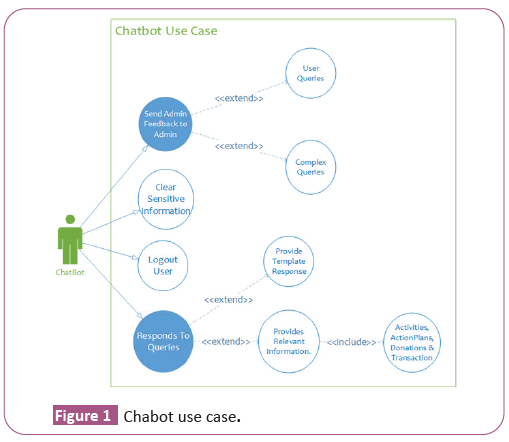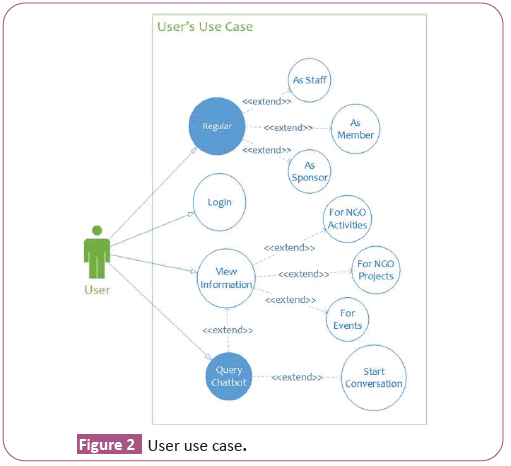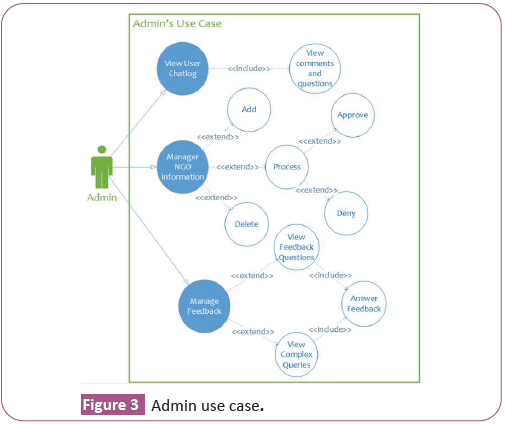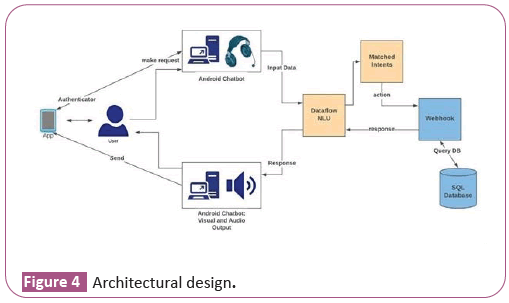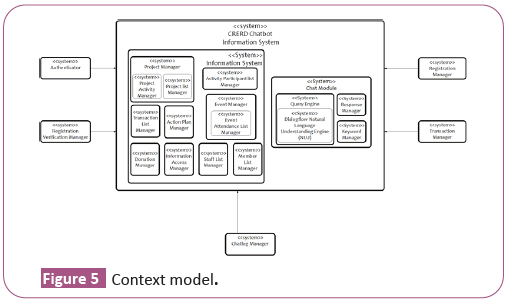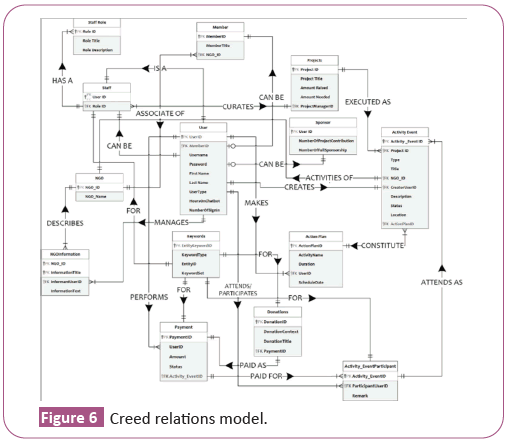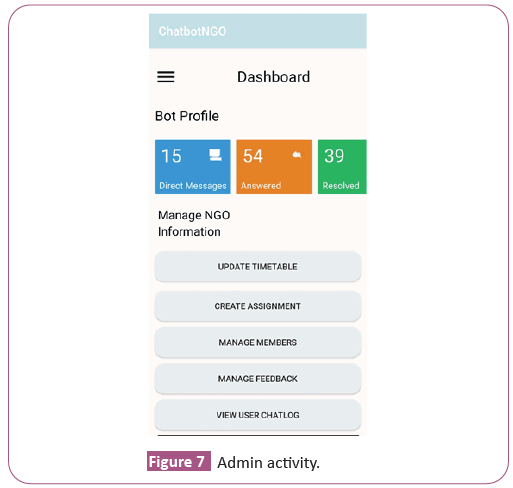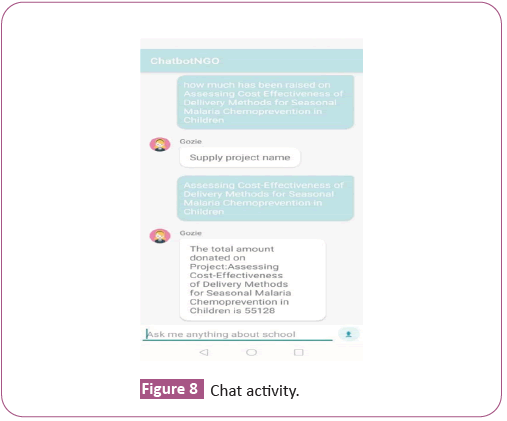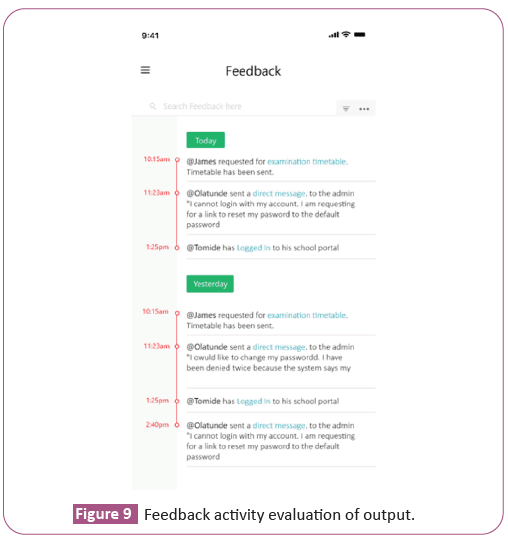ISSN : 2349-3917
American Journal of Computer Science and Information Technology
A Computerized Information System for Human Right Based Organization
Aaron Izang1*, Iheanacho Chiagozie A2, Ajayi Wumi S3, Omotunde Ayokunle A1 and Adesegun Oreoluwa2
1Department of Information Technology, School of Computing and Engineering Science, Babcock University, Ilishan-Remo, Ogun State, Nigeria
2Department of Computer Science, School of Computing and Engineering Science, Babcock University, Ilishan-Remo, Ogun State, Nigeria
3Department of Software Engineering, School of Computing and Engineering Science, Babcock University, Ilishan-Remo, Ogun State, Nigeria
- *Corresponding Author:
- Aaron Izang
Department of Information Technology, School of Computing and Engineering Science, Babcock University, Ilishan-Remo, Ogun State, Nigeria E-mail: izanga@babcock.edu.ng
Received Date: July 19, 2021; Accepted Date: August 02, 2021; Published Date: August 09, 2021
Citation: AIzang A, Chiagozie AI, Wumi SA, Ayokunle AO, Oreoluwa A (2021) A Computerized Information System for Human Right Based Organization. Am J Compt Sci Inform Technol Vol.9 No.8: 104.
Abstract
Information flow between human right organizations and members or users in need of assistance from various NGO is discovered to be poorly structured. This is as a result of lack of standard systems to convey such information. Hence, it is imperative that a computerized information system should be built to aid the poor flow of information between the organizations and their members, making such information readily available, secure and easily accessible just from the comfort of their homes.
This work designed a computerized information system for a human right based organization. Specifically, an android based chabot. The Chabot is readily available for human right organizations in order to help them carry out their duties more effectively and efficiently.
The designed android chabot is known as chatbotNGO. The system was implemented using Android SDK, Android studio, XAMPP server, Dialog flow, and Java programming language. The system is aimed at providing ease of operation for nongovernmental organizations, allowing seamless, efficient and secure flow of data and information within the organization.
Keywords
Computerized information system; Information; Android Chabot; Non- governmental organizations
Introduction
Today, a global civil society made up of Non-governmental organizations (NGOs), grows more powerful than governmental organizations assuming more responsibility for human development. An NGO is as a private non-profit, nongovernmental organization focused on serving specific community needs. Their popularity stems from their ability to address local problems directly using the participation of affiliated organizations, members, and volunteers. They have a symbiotic relationship with local communities such that as they improve their services, they encourage support from these local communities. While NGOs are still bounded by a national law, there is also a ‘soft law’ of the international world. Both state and non-state actors, international, national, and local are both the members and watchdogs of the NGO. Because of their flexibility, NGOs can be more powerful than national governments in serving local needs. They communicate more easily between organizations; however, if there are more people involved, there is more support and also scrutiny. The exponential growth of the modern NGO is due, in part, to the incorporation of ICT in organizational processes [1].
Information and Communications Technology (ICT) is allowing people to conduct their works effectively and easier. ICT extends its benefits not only to its contribution in the industry, but it has spread into the everyday life. Furthermore, current technologies allow communication to be conducted effectively, which is important when decision-making and response time in emergency situation plays a critical role. The effectiveness and speed in such situations are not the only factors that are important, but it is also important how this information is transferred and communicated. Humanitarian relief efforts have a great challenge to coordinate communications aspects and communications protocols among all of the organization in order to overcome many of the challenges when coordinating across institutions. Nongovernmental organizations (NGOs) are organizations who are mostly engaging in emergencies in order to help people that are faced with natural disasters such as fires, floods, storms, or violence, people conflicts, genocide, etc.
It is common for NGOs to have partners and collaborate with others who are not always local to where NGO activities are conducted and/or coordinated from. These partners and collaborators are often located all around the world, which in return requires effective and prompt communication for the best results [2].
ICT facilitates the intuitive improvement in effectiveness and communication as required over long-distance collaborations. However, currently the presence of ICT in NGO activities is very low. Mark & Katherine from research, realize that most NGOs are not using ICT in their activities and initiatives. When used properly, technology can provide NGOs with tools that can help people in real life situations. Moreover, ICT can provide not only the fast access to information, but it can also provide the necessary knowledge by bridging the distance and time differences. According to payout [3] the Internet could potentially be “the most powerful democratizing medium in the world”. ICT, like the Internet, allows a quick response to changes and opportunities in the global environment, and enables a stable free flow of communication between organizations [4].
This can preserve culture identities, while also expanding choices. In Cultural and Religious Identities in Era of Information and Communications Globalization, writes that, while cultural diversity reduces conflict and obstacle, too rapid an introduction of ICT could result in a homogenization of cultures, due to the fact that more is left to probability in use of this technology, than human processes. Alternately, too slow an introduction may widen the gap between the developing and developed world. Pejout warns of more dangers-there are two potential extreme outcomes to the introduction of ICT-an unstable power shift to a radical democratization, or more divisions which mirror those between the rich and poor. Unfortunately, while many countries struggle to build the organizational capacity and resources needed for ICT access and infrastructure, relevant decisions about topics in international ICT policy are made without them, like those in privacy, security, and intellectual property issues. Without the participation of every country, the idea of ICT as an equal and democratic forum for global communications is a contradiction in itself. Therefore, appropriate application is as important, if not more important, than availability and access to ICT, like the Internet [5].
A study conducted by World Wide Word on behalf of SANGONET, and sponsored by Microsoft and the NDA, showed that for the first time NGO decision-makers are becoming adept at cutting edge tools like mobile applications and social networking services. However, these are mostly being used in their personal capacity, with half of all respondents using local social networking services, but only 6% of them using it in pursuit of the goals of their organizations. The benefit of the pervasiveness of the personal use of advanced tools will be a faster adoption of these tools and methodologies, going forward [6].
In this study efforts are made to present how ICT can contribute to enhance initiatives and activities of NGOs. It is of particular interest to present challenges and barriers that can often occur during the collaboration between NGOs and ICT experts. In efforts to overcome these challenges the information system is adopted to tackle the information dissemination challenges of NGOs.
The aim of this paper is to integrate ICT with nongovernmental organizations. The current underlying method is no place to produce such organizations with optimum service and performance. Integrating said establishments with ICT ensures seamless operations, service delivery with optimum time management, maximum efficiency and all-round maximum productivity.
Related works
Bell was initially proposed in the field of machine interpretation, yet it can be connected in creating the discussion also [7]. The seq2seq display permits the consecutive and recursive mapping from encoded words to its assigned decoded portrayal till the terminal flag, i.e., the
Yinka-Banjo et al. [12] presented a study of evidence in the successful and relevant application of The Digital Education Enhancement Programmed (DEEP). In this project, the ability for ICT to support teacher professional development in Africa is examined.
Kadlec et al. [13] presents, a mobile application (English loose translation is ‘female who is safe’) represents a successful incorporation of ICT within the initiative of Serbian NGO and their activities in helping women that may be in any kind of a danger, using mobile phones and Bluetooth technology. Women can easily call the police, hospital, help lines or social services that are closest to their location. Also, they can send emergency SMS messages to their friends if they are in danger. However, very few researches have investigated the idea of creating a chat- bot with an artificial character and personality starting from web pages or plain text about a certain person. This paper describes an approach to the idea of identifying the most important facts in texts describing the life (including the personality) of an historical figure for building a conversational agent that could be used in middle-school CSCL scenarios.
Abdellatif et al. [14] which is an award-winning open source natural language artificial intelligence chat robot which utilizes AIML (Artificial Intelligence Markup Language) to form responses to queries. Alicebot engine and AIML are freely available under the terms of the GNU General Public License (used by GNU/Linux and thousands of other software projects). This is the general Chabot available in the industry which can be used for various purposes, but there is no Chabot for making college enquiries. Thus, we are designing a Chabot which will help students to do necessary enquiries without even going to the college.
Methodology
This section provides a gradual procedure outlined on the development of the system based on the methodology chosen. The requirement analysis phase was an integral part in the development of the application. This stage analyses the various functionalities that are used to achieve the project goals and objectives [15].
Functional requirements
SFunctional requirements are identified through the analysis of the data collected from the survey
• Showcase the platform in an aesthetically appealing way to users.
• The system must be able to allow users to login.
• The Chabot will assist users with their queries and return appropriate answers.
• Users will be able to converse with the Chabot text command and it will understand what the user is saying.
• The system must be able to provide text responses to users depending on what the user chooses.
• The system will be able ask needed question in order to authenticate the user when required
Non-functional requirements
Non-Functional requirements are identified through the analysis of the data collected from the survey [16].
• The Chabot must be reliable with little or no bugs.
• The Chabot must be efficient with very small lag in response time, as little as 6 seconds to reply a message.
• The Chabot must be secure.
• Use of natural language to interact with users.
• Providing accurate response to input questions.
• Handling of unexpected input and informing the user if it cannot provide any help or assistance.
• The intelligent Chabot cannot teach users how to undergo NGO processes
Use case and actors: These are classification of users who interact with the system directly or indirectly, with specific and active roles to play in the system [17]. This system has four actors which are users that interact with the system in the same way and the Chabot AI. These are the general users, members, administrators and the Chabot. The general users can be anyone that uses this platform to access public information about the NGO. The user is a pre-registered user that requires authentication to access confidential data. Some of the Preconditions used include;
• There is an active network connection to the Database.
• Admin approves users’ registration.
• Sensitive information is accessed by only registered users.
Use case diagram: The following are the activities that show how the users interact with the developed system (Figures 1-3).
System design: The design of this system was carried out using the requirements analyzed previously in order to produce a description of the systems internal structure that will serve as the basis to implement the system [18,19]. This will result in the systems architecture, showing how the system will be decomposed and organized into components alongside the interface of those components. The model design of this system, will form a blue print for the implementation that will be put together to achieve the project objectives and best performance for the final product. This system design consists of activities that fit between software requirements analysis and software construction (Figures 4-6).
System component: The system was developed in four components:
1) The Android Application: This component was developed using android studio as the integrated development environment and java programming language with the sole aim of providing a suitable interface for the “ChatbotNGO”.
2) The Chabot A.I: This component facilitates the intelligence of the Chabot system. An API called Dialog Flow made available by Google is responsible for this feature [20].
3) The System Database: MySQL database management system (DBMS) present in the XAMPP Server is responsible for managing dataflow in the system. CRERD NGO data and information is stored directly using the DBMS listed above
4) NGROK: This component was integrated into the system to facilitate the exposure of the database to the internet. These components have been integrated to ensure smooth operation of the system as a whole. The System in itself does not hold data. The API (Dialog Flow) enables the Chabot to perceive and understand human sentences and input. On acquisition of keywords present in user input, the Chabot AI queries the database to find matching sequence(s) and returns the value to the users as feedback on interaction with the android application [21,22]. In the case of unavailability of the AI response, the user is asked to rephrase the input in order to get an accurate response. The effectiveness and efficiency of this study is largely dependent on how well the Chabot AI is trained. The database as mentioned above is exposed to the internet in order to reduce response time between questions asked or user input and system feedback.
System implementation evaluation and discussion: The development tools adopted for this project is the Android Studio. This tool enables rapid build of Graphical User Interface (GUI) suited for the Top down development approach adopted for this system’s development methodology in chapter 1. The ease in developing Graphical User Interface allowed focus to be directed mainly on the logic of the system [23].
Implementation platform: This section describes the type of technology available and technological consideration and constraints for delivery of the solution. In essence, a technology analysis helps yield information about the infrastructure capabilities of a company and the current technologies being used. Media analysis, an inherent part of technology analysis yields information on the most appropriate delivery systems for a particular application, given the state of infrastructure of the target organization.
This section describes the application software developed for this project and how it satisfies project objective, in essence of the core components and inputs that capture information by interaction of the operator with the simulation system. Below is a listing of the android activities:
1) Admin Activity
2) Chat Activity
3) Feedback Activity
Admin activity: This activity provides the administrator the functionality to manage the information to be queried on this platform by member users [24,25].
Chat activity: This activity provides the chat module feature that facilitates direct communication between users and Chabot, and Admin. The Chabot for this project is a persona and a name “James”. The Chabot is trained to identify keywords in user’s messages and map to certain replies as retrieved from the database. Complex queries are sent to admin for further processing which automatically trains the Chabot AI. General questions are information that concern Staff such as Sponsorship and NGO events.
Feedback activity: Administrator uses this activity to view feedback of user activities and interactions on this platform (Figures 7-9).
In the evaluation of the system, the software is tested by a student in the department of computer science, Babcock University, which will account for serval real-life scenarios, and benchmarked on the parameters listed below:
1) Comprehension
2) Security
3) Speed
The querying process will be simulated several times and recorded, to enable proper analysis of data processing by Chabot under varying scenarios [26].
Discussion of findings: As observed from our results, the software satisfies the project object of disseminating information to member user via the Chabot.
As observed from our results, the software satisfies the project object of disseminating information to member user via the Chabot AI (Table 1).
| Performance metric | Genetic algorithm vs. Hungarian algorithm |
|---|---|
| Comprehension | As recorded in the result section, the system was able to comprehend the information of student with 80% Accuracy, with apt results. |
| Security | At every instance a user account queries the chatbot AI for confidential information; the system prompted the user for authentication. In scenarios where the queries were complex, the information is forwarded to the admin for further processing which intrinsically trains the chatbot AI. |
| Speed | The system delivered result queries at an average of 0.05seconds. It is observed that simpler and shorter the queries take lesser time taken to process queries. |
Table 1: Disseminating information to member user via the chabot AI.
This study has proved beyond a doubt that Chabot’s are more than standard information system used to manage information operated by several user types. The chat module provides an interactive and intuitive manner of managing data with less effort. Information is more concise and users do not need to navigate through a series of web pages to access information. NGOs can be made to operate from the remote location with little infrastructure, members who are not located within close proximity of NGO offices, the Chabot system allows the members maintain operational efficiency. The ubiquity of mobile devices makes this form of information management system, efficient.
Conclusion and Recommendation for Further Study
This paper was directly aimed at solving a prominent problem in the mode of operation of non-governmental organizations. The paper addressed the lack of interaction between ICT and non- governmental organizations in the transmission, management and flow of data. The system was successfully designed to address this problem, providing a more efficient, reliable and secure means to control and manage information flow within and outside the organization.
For Future research, it is expected that certain information would be too complex to process in real-time or data-required to process certain queries are unavailable. The notification manager will notify users on completion of pending queries. This module could also be used by staffs to send broadcast message to member users of this platform, which could be read aloud by the text-to-speech engine.
Due to the sensitivity of information on this platform, users should be able to report information perceived as misinformation, which can be contested. The feature allows the users moderate the information, because every information system which require user input (i.e. as administrator), there is a tendency for error, and if left unchecked, the information can be misleading. The system is recommended for other NGOs to employ in order to facilitate efficient information flow between the organization, its users, and donors.
References
- Haller E, Rebedea T (2013) Designing a Chat-Bot that Simulates an Historical Figure. In 2013 19th International Conference on J Comput Sci Control Syst 12 : 582-589.
- Saeed, Rohde & Wulf (2008) Pejout, Dangers of ICT in Market Incorporation.
- Fukuda-Parr S (2001) Human Development Report Making New Technologies Work for Human Development.
- Brichford M (1977) Current Status of the American Library Association Archives: A Preliminary Report. J libr hist 12: 64-69.
- Hayman R (2009) Human Rights Software: Information Support Solutions for Social Justice.
- Braunwald E, Antman EM, Beasley JW, Califf RM, Cheitlin MD, et al. (2002) ACC/AHA guideline update for the management of patients with unstable angina and non–st-segment elevation myocardial infarction. summary article: A report of the american college of cardiology/american heart association task force on practice guidelines (Committee on the management of patients with unstable angina) circulation 106: 1893-1900
- BELL D (2005) Software Engineering for Students: A Programming Approach Fourth Edition.
- Constantin, L (2017) AI-Based Typing Biometrics Might Be Authentication’s Next Big Thing.
- Saab DJ, Tapia A, Maitland C, Maldonado E, Tchouakeu LM (2013) Inter-organizational coordination in the wild: trust building and collaboration among field-level ICT workers in humanitarian relief organizations. Int J Nonprofit Volunt Nonp Org 24: 194-213
- Gibelman M, Gelman SR (2004) A loss of credibility: Patterns of wrongdoing among nongovernmental organizations. Int J Nonprofit Volunt Nonp Org 15: 355-381
- Leach J (2005) Do new information and communication technologies have a role to play in achieving quality professional development for teachers in the global south? J Curric 16: 293-329
- Yinka-Banjo C, Abayomi AK, Ohalete PI (2021) Application of genetic algorithm to the job assignment problem with dynamics constraints. Cov J Inf Commun Technol 27: 8-10.
- Kadlec R, Schmid M, Kleindienst J (2015) Improved deep learning baselines for ubuntu corpus dialogs. arXiv preprint arXiv 3: 21-26.
- Abdellatif A, Costa D, Badran K, Abdalkareem R, Shihab E (2019) Challenges in Chatbot Development: A study of Stack Overflow Posts. In Proceedings of the 17th International Conference on Mining Software Repositories 2: 174-185.
- Larsen A, Ytzen F (1990) How the world bank works with nongovernmental organizations. The world bank.
- Lowe R, Pow N, Serban I, Pineau J (2015) The Ubuntu Dialogue Corpus: A large Dataset for Research in Unstructured Multi-Turn Dialogue Systems.
- Matsushima T, Kondo N, Iwasawa Y, Nasuno K, Matsuo Y (2020) Modeling task uncertainty for safe meta-lmitation learning. Front Robot AI 7: 189-192.
- Neyestani MR (2005) Cultural and religious identities in era of information and communications globalization. Altern Turk J Int Relat 4: 33-39.
- NGO Pulse (2010) Microsoft's "ICTs for NGOs" Day.
- Maboya M, McKay T (2010) The financial Sustainability Challenges Facing The South African Non-Profit sector
- Pantic M, Zwitserloot R, Grootjans RJ (2005) Teaching Introductory Artificial Intelligence using a Simple Agent Framework. IEEE transactions on education 48: 382-390.
- Péjout* N (2004) The communication of communication. An illustration: The south african rhetorical promotion of ICTs. Politikon 31: 185-199
- Reid GE, McLuckey SA (2002) ‘Top down’protein characterization via tandem mass spectrometry. J Mass Spectro 37: 663-675.
- Roosa J (2007) How Does a Truth Commission Find Out What The Truth Is? The Case of East Timor's CAVR Pacific Affairs 1: 569-580.
- Saab DJ, Tapia A, Maitland C, Maldonado E, Tchouakeu LM (2013) Inter-organizational coordination in the wild: trust building and collaboration among field-level ICT workers in humanitarian relief organizations. Int J Nonprofit Org 24: 194-213
- Saeed S, Rohde M, Wulf V (2008) Designing IT systems for NGOs: Issues and directions. In World summit on knowledge society 1: 560-565.

Open Access Journals
- Aquaculture & Veterinary Science
- Chemistry & Chemical Sciences
- Clinical Sciences
- Engineering
- General Science
- Genetics & Molecular Biology
- Health Care & Nursing
- Immunology & Microbiology
- Materials Science
- Mathematics & Physics
- Medical Sciences
- Neurology & Psychiatry
- Oncology & Cancer Science
- Pharmaceutical Sciences
